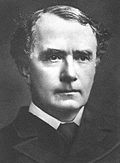|
Birmingham East (UK Parliament constituency)
Birmingham East was a parliamentary constituency in the city of Birmingham, England. It returned one Member of Parliament (MP) to the House of Commons of the Parliament of the United Kingdom, elected by the first-past-the-post voting system. The constituency was created upon the abolition of the Birmingham constituency in 1885, and was itself abolished for the 1918 general election. BoundariesBefore 1885 Birmingham, in the county of Warwickshire, had been a three-member constituency (see Birmingham (UK Parliament constituency) for further details). Under the Redistribution of Seats Act 1885 the parliamentary borough of Birmingham was split into seven single-member divisions, one of which was Birmingham East. It consisted of the wards of Duddeston and Nechells, the local government district of Saltley, and the hamlet of Little Bromwich. The division was bounded to the west by Birmingham North, to the north by Aston Manor, to the east by Tamworth and to the south (from west to east) by Birmingham Central, Birmingham South and Birmingham Bordesley. In the 1918 redistribution of parliamentary seats, the Representation of the People Act 1918 provided for twelve new Birmingham divisions. The East division was abolished. Members of Parliament
ElectionsElections in the 1880s

Matthews was appointed Home Secretary, requiring a by-election.
Elections in the 1890s

Elections in the 1900s
Elections in the 1910s
General Election 1914–15: Another General Election was required to take place before the end of 1915. The political parties had been making preparations for an election to take place and by July 1914, the following candidates had been selected;
In popular cultureBirmingham East was used in BBC sitcom Yes Minister, and Jim Hacker was its MP. Although Hacker's Party was left unspecified, he was shown to be elected in the fictional 1981 general election, defeating a Conservative and Labour challenger. During the declaration of the result, Hacker was shown wearing a white rosette.
See alsoNotes and ReferencesNotes
References
|
||||||||||||||||||||||||||||||||||||||||||||||||||||||||||||||||||||||||||||||||||||||||||||||||||||||||||||||||||||||||||||||||||||||||||||||||||||||||||||||||||||||||||||||||||||||||||||||||||||||||||||||||||||||||||||||||||||||||||||||||||||||||||||||||||||||||||||||||||||||||||||||||||||||||||||||||||||||||||||||||||||||||||||||||||||||||||||||||||||||||||||||||||||||||||||||||||||||||||||||||||||